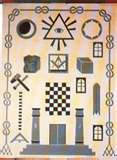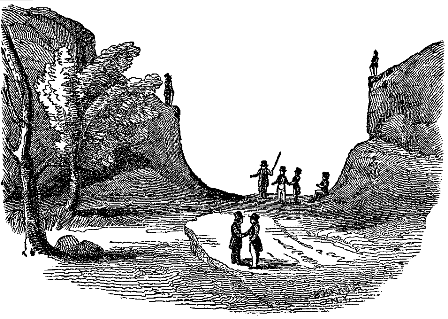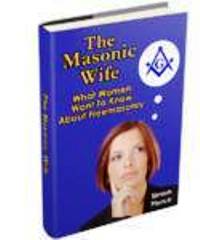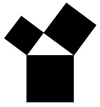What Is A Masonic Trestle Board?
Masonic Tracing Board

Why Freemasons "Square" The Lodge Room
A Masonic trestle board is a design board for the Master Workman (Architect) to draw his plans and designs upon to give the workmen an outline of the work to be performed. In today's terms, we might call it a blueprint.
It is one of the 3 Movable jewels.
A trestle board is a framework consisting of (usually 3) vertical, slanted supports (or legs) with one or more horizontal crosspieces on which to hang or display an item. Today, it is better known as an "easel".
Some jurisdictions around the world call it a tracing board. It would be somewhat of a "circular logic" task to argue the difference, as, while neither can be fully proven (in historical writings), the "Tracing board" may very well have predeceded (come before) the use of the word "Trestleboard" because lodges in Europe (which pre-date American lodges), use the word "Tracing Board".
Hiram's Tracing Board
Hiram Abif's tracing board is believed to have been made of wood, covered with a coating of wax. Each day he would draw his Master architect's measurements and symbols into the wax in order to instruct his Master Masons of the work that was to be accomplished.
At the end of the day, he would simply scrape off the wax and pour a new layer of hot wax onto the board to ready it for the next day's work.
Masonic Tracing Board
Much later, in the days where lodge was held in secret areas and on hills and vales, (valleys) once lodge was in session, the Tiler (or Tyler) would draw an oblong (rectangular) or oblong square depiction (image) into the dirt that represented the form of the lodge.
Again, onto that tracing board was drawn the architect's plan...the working tools in the degree that was to be worked.
Masonic Trestle Board
Through the years, the Masonic Tracing Board progressed to charcoal or chalk on the floor of taverns where lodges were held back in the 1700s. After the lecture, the Stewards or the Entered Apprentice, as a lesson in secrecy, would get a mop and bucket and remove all trace of these drawings.
This, obviously, was a somewhat tedious and messy procedure, so cloths or rugs were created which could be laid onto the floor and simply folded up when the lecture was complete.
Later, these cloths (or rugs) were placed onto a table. As time passed, they were finally hung onto an easel...(a trestle board) much like a drawing board at a construction site where each workman could receive clear instruction as to what his specific participation entailed.
When the team's work was completed, it was obvious that each Master Mason not only understood their specific part in the undertaking, but how their part (no matter how small), contributed to the construction of the entire edifice (building).
The meaning of the words "Nothing further remains to be done, according to ancient custom, except to disarrange our emblems" is a reference to the now antiquated use of these trestleboards (or tracing boards) during which the dirt on the ground was erased or the chalk marks on the floor of these lodges was mopped or scrubbed, to leave no trace of the form of the Lodge or the contents drawn thereon.
The reason why our lines of travel are at right angles within the lodge and thus the reason that we "square" the lodge is a "throwback" to the antiquity of the ritual.
If the brethren were to walk atop the markings made in the dirt on hill and vale; atop the chalk on the floor of the taverns; or tread upon and thus soil the cloths or rugs used to provide the workings of that degree, the message of that lecture which was being worked could be partially or fully destroyed.

Therefore, "Squaring the Lodge" in a semi-military-like precision, goes back many centuries as the means of preserving the ritual and the degrees being worked so as not to destroy the symbolism of their markings before their usefulness on that day has been completed.
How old is the use of Tracing Boards?
Click on the link, below, to read about this tracing board which was found during an excavation of the Mount Vesuvius volcano eruption in 79 AD,...1800 years before its discovery in 1874.
Masonic scholars note its similarities to today's Freemasonry trestle boards.
Many modern-day lodges now simply use a emailed newsletter to notify the brethren of a degree which will be worked.
Low Cost Lodge Website Trestle Board:
One of the easiest ways, today, to notify the majority of the brethren (those with internet access) is to add an event calendar to your lodge's website.
_____________________
Simon-Sez: Your Worshipful Master should designate (request) a member who is able to keep your trestle board updated at all times. The lodge Secretary should have all the member contact information.
Unless he volunteers to do so, it is best to have another member input the contact information into the lodge e-mail Address Book and to keep it updated. If your lodge has a Communication Officer, this would fall under his duties.
This is an excellent way to keep in touch with the brethren as to lodge degrees and functions. Begin placing each member's contact info and e-mail address into the lodge e-mail Address Book to be able to quickly broadcast this Electronic Trestle Board information to the brethren.
Even better, Yahoo gives you the ability to print address labels directly from your Yahoo! Address Book which can be very handy when it comes time to send out dues notices.
Best of all, when the Secretary steps down, and a new Secretary takes his place, the lodge member contact information is not housed on one computer (that of the Secretary), but on Yahoo's server, which is mirrored and backed up to provide zero downtime and zero data loss over the years.
This Address Book function coupled with a public calendar for your electronic Trestle Board provides much safer data protection than a single computer owned by the Secretary...even if he is excellent at performing back-ups of his hard drive.
Related Pages:
Back from Trestle Board to Freemason Symbols
5 Fast Methods To Find the Information You Want to Learn About
- Search Box - Use the Search Box at the top of your page.
- Site Map - Use my Site Map page to find the topics you are most interested in.
- Carousel - Use the carousel of pages at the top of your screen.
- Menu Icon - On MOBILE, click the MENU button at the top of each page.
- Masonic Books - Browse through a selection of Masonic books.






